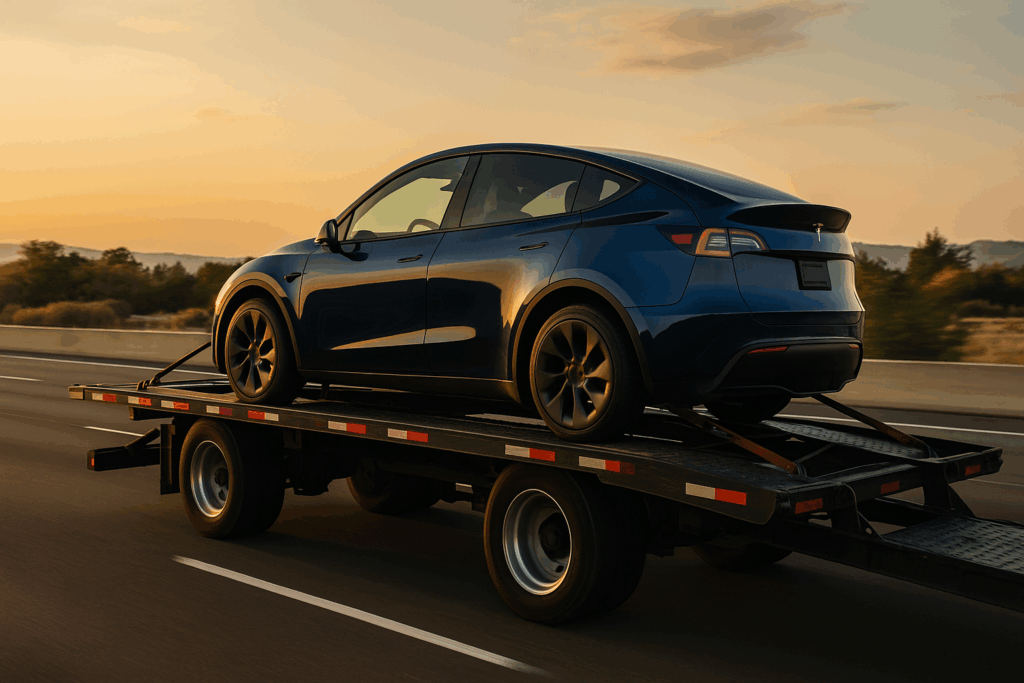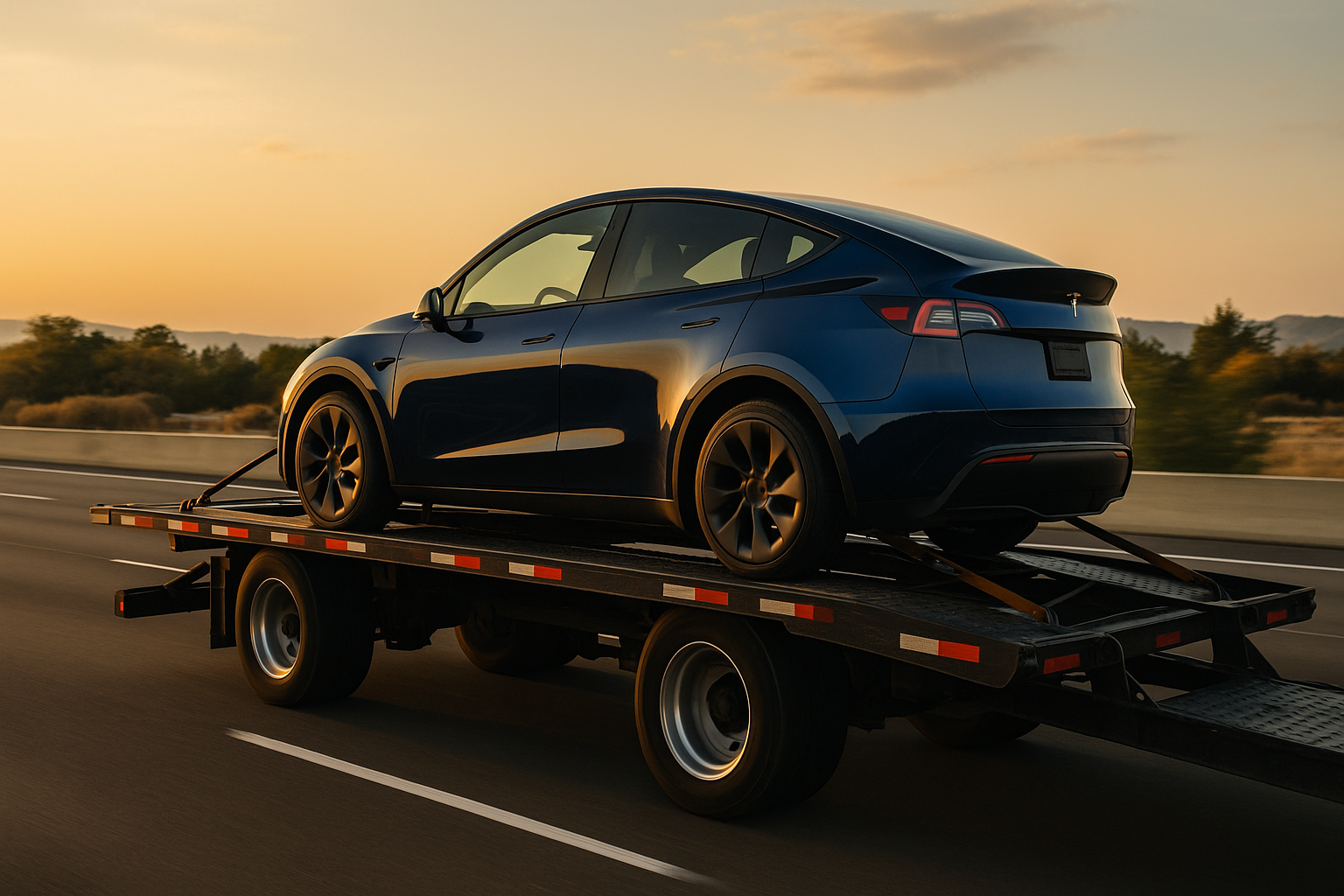Introduction
Shipping an electric car isn’t the same as transporting a gas-powered vehicle. With advanced battery systems, low ground clearance, and unique tow settings, EVs require special care—and the right shipping partner. Whether you’re moving across the country, buying a new Tesla online, or sending your Rivian or Ford Mustang Mach-E to a family member, understanding how shipping an electric car works is essential.
In this blog, we’ll break down exactly what makes shipping an electric car different, why it matters, how to do it the right way, and where to find experienced, EV-savvy help.

What Makes Shipping an Electric Car Different?
EVs are engineered differently from internal combustion engine (ICE) vehicles. Here are the main differences that impact shipping an electric car:
- Battery weight: EVs are heavier due to large battery packs. A Tesla Model S can weigh over 4,500 pounds, requiring specific carrier load planning.
- Low ground clearance: Sports EVs like the Porsche Taycan often have lower clearance, making them vulnerable during loading.
- No neutral gear: Many EVs can’t be rolled easily without damaging the motor unless specific tow settings are used.
- Charging status: Carriers must ensure the battery is partially charged (usually around 20% to 50%) for safe shipping and unloading.
These differences make it critical to hire a carrier experienced in shipping an electric car.
Why Proper EV Transport Matters
Shipping an electric car is about more than just loading it onto a trailer. Poor planning or mishandling can result in:
- Scraping or underbody damage
- Battery system disruption
- Drained battery on arrival
- Costly repairs due to improper towing techniques
EVs are high-value, high-tech machines. Investing in professional transport helps preserve performance, warranty coverage, and long-term vehicle health.
Common Mistakes to Avoid When Shipping an Electric Car
- Failing to Notify the Carrier It’s an EV
Not all carriers are prepared for EVs. Telling them upfront allows for proper planning. - Not Setting Transport Mode or Tow Mode
Most EVs have a special setting that disables regenerative braking and prepares the car for rolling. - Shipping with a Fully Charged Battery
Overcharging can be risky in extreme temperatures. Aim for 20%–50%. - Using a Basic Open Carrier for High-End EVs
While open carriers are cost-effective, enclosed transport is safer for luxury electric cars. - Skipping Pre-Shipment Documentation
Always inspect and photograph your EV—inside, outside, and underbody—before handing it off.
Avoiding these mistakes can make a huge difference when shipping an electric car.
How to Ship Your EV the Right Way
Shipping an electric car properly starts with preparation and ends with working with an expert logistics partner. Here’s how:
- Book with an EV-experienced company: Ask if they’ve shipped Teslas, Rivians, or Lucid vehicles before.
- Select enclosed transport (if applicable): Especially important for luxury EVs.
- Document the vehicle’s condition: Include photos of interior screens, charging ports, and undercarriage.
- Charge the battery to 30–50%: Not too high, not too low.
- Activate transport or tow mode: Do this before the carrier arrives.
- Remove charging accessories: Unless agreed upon, don’t leave them in the car.
Each step is crucial when shipping an electric car securely and efficiently.
Cost to Ship an EV vs. a Gas Vehicle
| Type of Vehicle | Average Shipping Cost (1000 miles) | Notes |
| Gas-powered Sedan | $900 – $1,100 | Standard weight and clearance |
| Tesla Model 3 | $1,000 – $1,300 | EV weight and tech handling required |
| Porsche Taycan (Enclosed) | $1,400 – $1,800 | Luxury EV, low clearance, enclosed trailer |
The slightly higher cost of shipping an electric car reflects the added complexity and care needed.
Where to Find the Best EV Shipping Services
At Minute By Minute Logistics, we specialize in shipping electric cars of all types—from budget EVs to six-figure Teslas and Lucids. Our services include:
- EV-specific experience with tow modes and battery systems
- Open and enclosed trailer options nationwide
- Full coverage insurance included
- Real-time tracking with customer updates
If you’re serious about shipping an electric car safely, MBM Logistics is the trusted choice.
Conclusion
Shipping an electric car doesn’t have to be stressful. With the right preparation and the right transport partner, your EV can arrive at its destination damage-free, on time, and fully protected. From setting the correct tow mode to choosing the right carrier, every detail matters.
Trust Minute By Minute Logistics to move your EV with care, precision, and peace of mind.
🚗 Request your EV shipping quote here and get rolling the smart way.


Leave a Reply